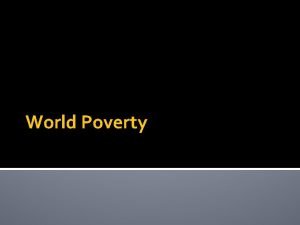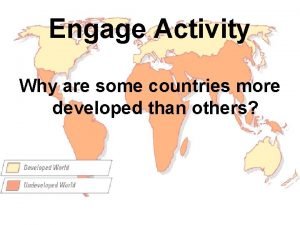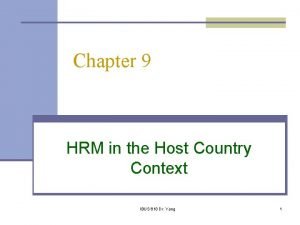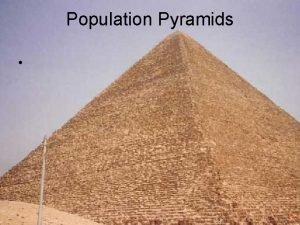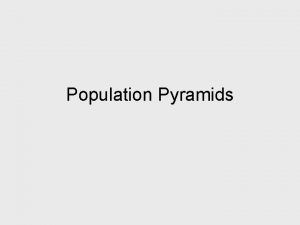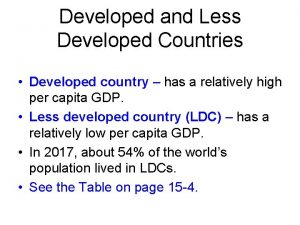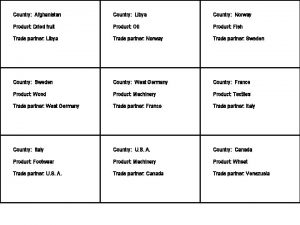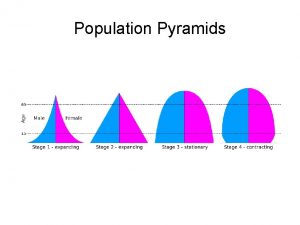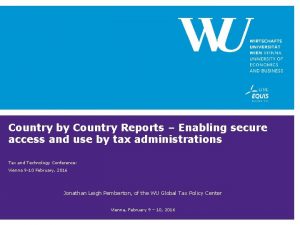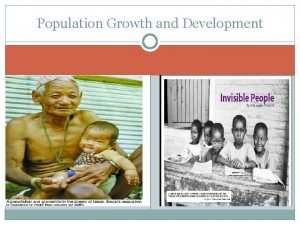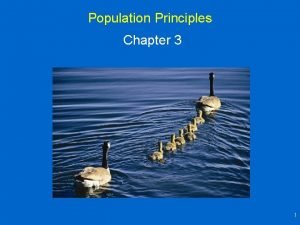Population Development MDCMore Developed Country Developed Access to



















- Slides: 19

Population

Development • MDC-More Developed Country • “Developed” – Access to resources, water, money, jobs, technology, healthcare, transportation, education etc. • LDC- Less Developed Country • “Developing” – Lacks most of the above.

How is population measured? • Crude birth rate (CBR) • Crude death rate (CDR) • Natural increase rate (NIR)

Crude Birth Rate • 1 birth for every 1, 000 people already living. • For example the United States CBR is 13 • 13 people are born for every 1, 000 that are currently living. • 13 X (321 million divided by 1, 000)= 4. 1 million babies are born each year


Crude Death Rate • The total number of deaths per year for every 1, 000 people still living. • For example the United States CDR is 8 • 8 people die for every 1, 000 that are still living. • 8 x (321 million people divided by 1, 000)= 2. 5 million people die each year • It is important to know that CDR is not as reflective, developmentally, as CBR is. • Some Developed countries can and do, have higher CDR’s than developing countries.


Natural Increase Rate • Percentage by which a population grows in a year. • Crude Birth Rate --- minus--- Crude Death Rate • 13 minus 8 = 5 • Growth is 5 per 1, 000 people • . 50% growth rate • Less than one percent population growth **does not include migration/immigration


Total Fertility Rate • The number of children a woman will have**predicted to have** during her childbearing years (15 -49) • TFR for the world is 2. 5 • In European countries that number is 2 or less • In Saharan Africa that number is closer to 5 or more • This number is used to predict behavior of women, individually, where CBR is reflective of a society in a given year.


Infant Mortality Rate • The number of deaths per infant (under the age of 1) in a given year compared to surviving children. • IMR in Sub-Saharan Africa exceeds 60. More than 6% of infants born die before one. • IMR reflects a countries healthcare system. • US 6. **although minorities in the US have an IMR twice as high as the national average. This tends to be attributed to poverty and less access to prenatal and post natal care.


Life Expectancy • Average number of years an infant can expect to live at current mortality rates. • Sub-Saharan Africa in their 40’s. • US 75 -79 years old.


Age is but a number • 33% of the population in developing countries are under the age of 15 • 16% of population in developed countries are under the age of 15 • Children are expensive. A country with a large population of children must allocate their resources to day-care, health care, schools, etc. • Additionally, as they age they will need a government that has a growing job market but is difficult to do when funds are going to the children. • However, in countries with low percentages of children, we see increase job demand programs to be paid without a viable work force to pay for them.

How do we see it? Population Pyramids • A way to display a countries age and gender through a bar graph. – Percentage of the population in each age group and distribution of males/females. • % • Age • Male or Female


 Developed country
Developed country Developed country
Developed country Least developed country
Least developed country Is cyprus a developed country
Is cyprus a developed country Host country and home country
Host country and home country Intra country vs inter country
Intra country vs inter country Newly industrialized country population pyramid
Newly industrialized country population pyramid Italy demographic pyramid
Italy demographic pyramid Section 1 population dynamics answer key
Section 1 population dynamics answer key Section 1 population dynamics
Section 1 population dynamics Population ecology section 1 population dynamics
Population ecology section 1 population dynamics Study guide chapter 4 section 1 population dynamics
Study guide chapter 4 section 1 population dynamics Terminal access controller access control system
Terminal access controller access control system Terminal access controller access-control system
Terminal access controller access-control system Aspects of development in a country
Aspects of development in a country What are the history of community development in tanzania?
What are the history of community development in tanzania? Development that ended much development crossword
Development that ended much development crossword What is the purpose of the
What is the purpose of the Abrasive water jet machining advantages and disadvantages
Abrasive water jet machining advantages and disadvantages Unix was originally developed in
Unix was originally developed in
